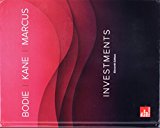
Concept explainers
(A)
Adequate information:
The portfolio that is required to be managed is worth $1 million. The target duration stands to be 10 years. The manager has a choice of two bonds, perpetuity and 5 year maturity zero coupon bond.
To determine:
What proportion of the portfolio must be allocated towards the perpetuities and zero coupon bonds
Introduction:
Zero coupon bonds refer to the debt security that does not pay any interest payment and sold at a discount to the bondholder. It is the bond which does not make any periodic interest payment or coupon payment during its life rather it is sold at a price less than its face value. These bonds are redeemed at its face value and the difference is the profit earned by the bondholder.
(B)
To determine:
What proportion of the portfolio must be allocated towards the perpetuities and zero coupon bonds if target duration now account for 9 years
Introduction:
Zero coupon bonds refer to the debt security that does not pay any interest payment and sold at a discount to the bondholder. It is the bond which does not make any periodic interest payment or coupon payment during its life rather it is sold at a price less than its face value. These bonds are redeemed at its face value and the difference is the profit earned by the bondholder.
Want to see the full answer?
Check out a sample textbook solution
Chapter 16 Solutions
Investments, 11th Edition (exclude Access Card)
- Bobby Nelson, made deposits of $880 at the end of each year for 6 years. Interest is 6% compounded annually. What is the value of Bobby’s annuity at the end of 6 years?arrow_forward1. Find the future value if $1,250 is invested in Simple interest account paying 6.5%: a. for 5 years b. for 20 years 2. Find the future amount $ 35,000 is invested for 30 years at 4.25% compounded: a. annually b. Quarterly c. monthly d. weekly 3. How much should be put into an account today that pays 7.75% compounded monthly if you need $10,000 in 5 years. 4. Find the effective rate for: a. 5.75% compounded quarterly b. 6.25% compounded daily. 5. $50 is invested at the end of each month into an account paying 7.5% compounded monthly. How much will be in the account after 5 years?…arrow_forwardSolve step by step no aiarrow_forward
 Essentials Of InvestmentsFinanceISBN:9781260013924Author:Bodie, Zvi, Kane, Alex, MARCUS, Alan J.Publisher:Mcgraw-hill Education,
Essentials Of InvestmentsFinanceISBN:9781260013924Author:Bodie, Zvi, Kane, Alex, MARCUS, Alan J.Publisher:Mcgraw-hill Education,

 Foundations Of FinanceFinanceISBN:9780134897264Author:KEOWN, Arthur J., Martin, John D., PETTY, J. WilliamPublisher:Pearson,
Foundations Of FinanceFinanceISBN:9780134897264Author:KEOWN, Arthur J., Martin, John D., PETTY, J. WilliamPublisher:Pearson, Fundamentals of Financial Management (MindTap Cou...FinanceISBN:9781337395250Author:Eugene F. Brigham, Joel F. HoustonPublisher:Cengage Learning
Fundamentals of Financial Management (MindTap Cou...FinanceISBN:9781337395250Author:Eugene F. Brigham, Joel F. HoustonPublisher:Cengage Learning Corporate Finance (The Mcgraw-hill/Irwin Series i...FinanceISBN:9780077861759Author:Stephen A. Ross Franco Modigliani Professor of Financial Economics Professor, Randolph W Westerfield Robert R. Dockson Deans Chair in Bus. Admin., Jeffrey Jaffe, Bradford D Jordan ProfessorPublisher:McGraw-Hill Education
Corporate Finance (The Mcgraw-hill/Irwin Series i...FinanceISBN:9780077861759Author:Stephen A. Ross Franco Modigliani Professor of Financial Economics Professor, Randolph W Westerfield Robert R. Dockson Deans Chair in Bus. Admin., Jeffrey Jaffe, Bradford D Jordan ProfessorPublisher:McGraw-Hill Education





